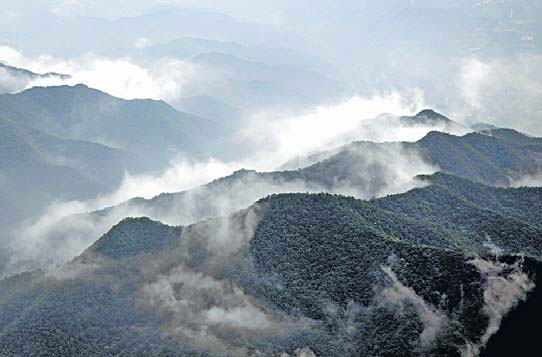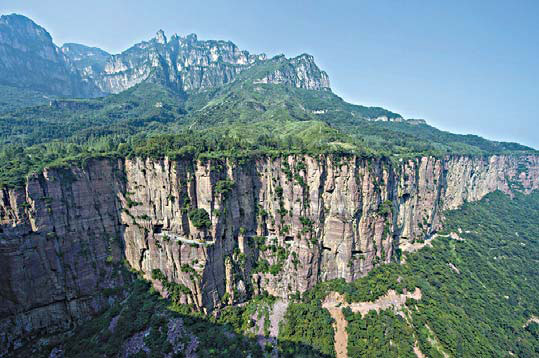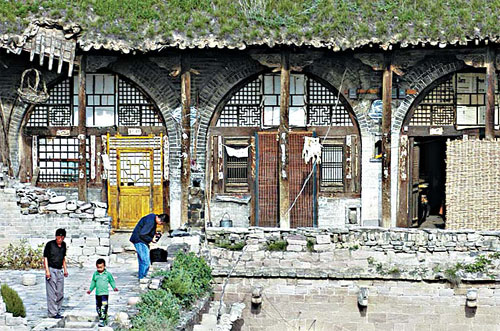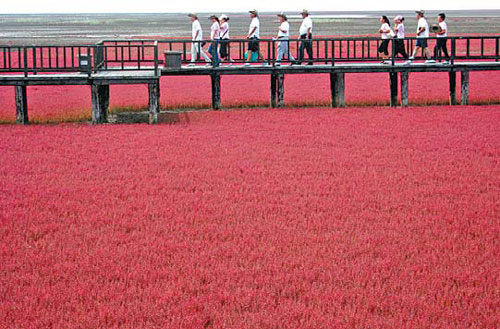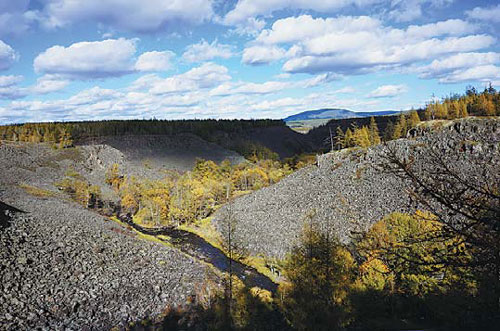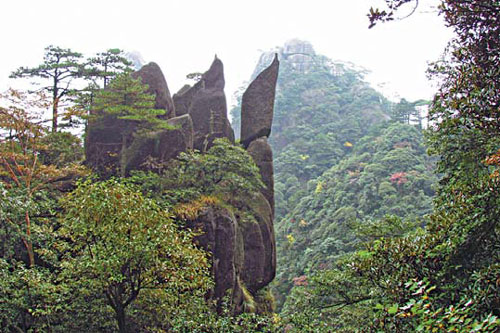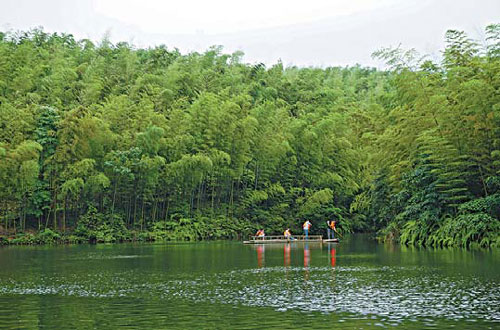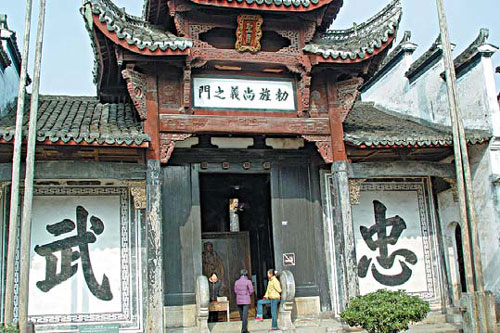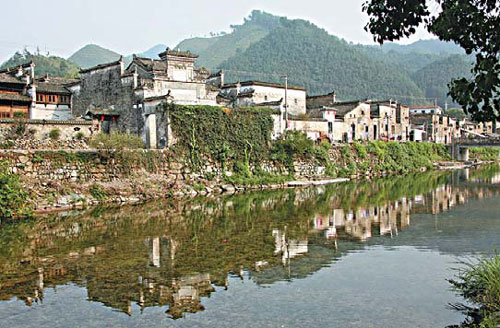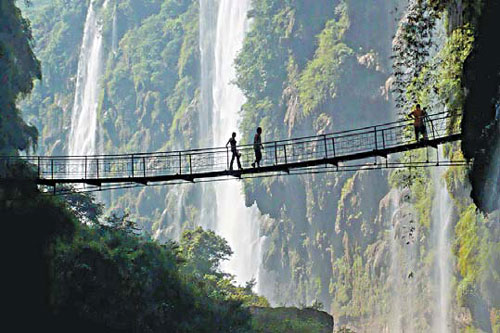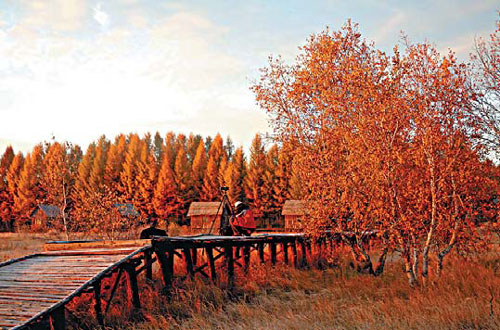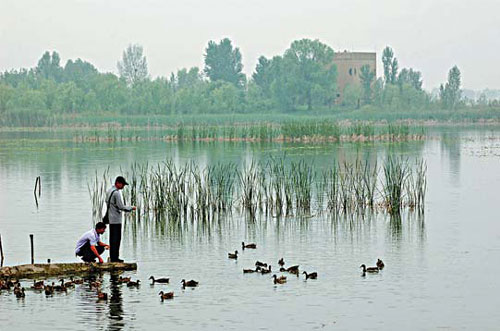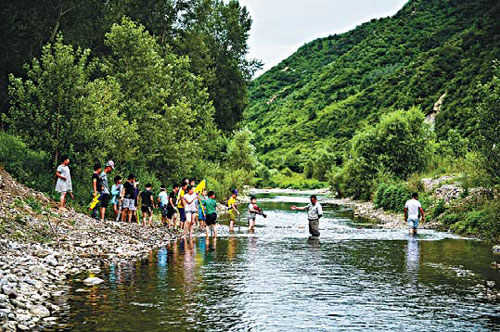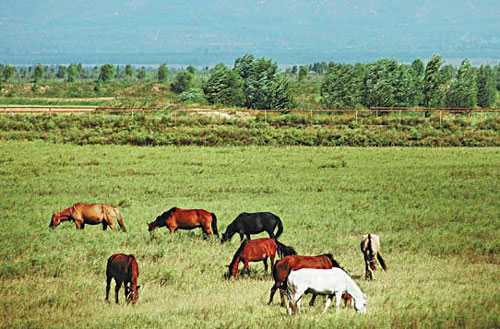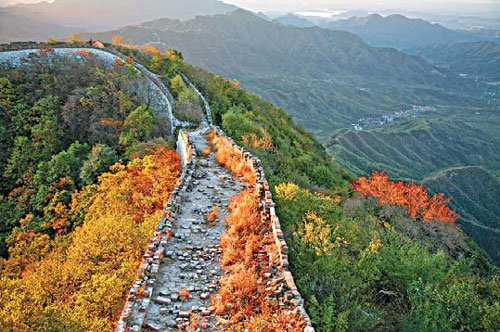Places less traveled
Updated: 2014-10-04 08:57
By Liu Xiangrui
|
||||||||
People seeking relaxation during the National Day (Oct 1) holidays may find themselves in a dilemma.While a nice trip during the one-week break may seem a good choice, it could also end up in disappointment, considering the overwhelming crowds cramming all the popular tourist sites around the country.In recent years, news headlines have shown visitors jamming tourist attractions like the Forbidden City and the Great Wall in Beijing as well as the West Lake in Hangzhou, Zhejiang province, even capturing the attention of those who didn't travel.Well, could Robert Frost's poem about taking the road less traveled give us a little inspiration for choosing your destinations?Instead of rushing to well-known sites only to be caught in long lines and huge crowds, you can explore some less-traveled places that have their own unique charms and scenery. From vast grasslands, picturesque river canyons, magnificent mountains to historic water towns or villages, we have come up with a list of optional travel destinations based on the recommendation of travelers and our own experiences.
In North China
1. Mount Wangwu and the Three Gorges on the Yellow River
The first place we recommend is in western Jiyuan, Henan province, where the alpine splendor of the Taihang Mountains and the mighty Yellow River combine to create a spectacular scene.
On a map, the 400-kilometer-long Taihang mountain range looks as if it were being hugged by the river near its southern tail, where Mount Wangwu stands.
Conquering its 1,715-meter-high summit is a physical challenge if you climb on foot and a mental one if you ride the funicular car that sways hundreds of meters in midair. But it's worth it. Those who reach the summit find Mount Wangwu dwarfs the rest with its majestic view.
Many Taoist temples dot the mountain. Mount Wangwu also boasts various geological marvels and became a world geological park in 2006.
The Three Gorges on the Yellow River are about 20 km from Mount Wangwu and can be seen on a good day.
The landscape along the gorges, with chains of mountains competing in beauty, is a rare blend of water and peaks, especially in North China. Each of the gorges has its own unique facets.
All you need to do is to board a cruise ship at the dock and feast your eyes. The 20-km boat trip will take you to another scenic splendor - the Xiaolangdi hydro-junction, the largest water-control project on the river.
Xitan, a small island spotted with village cottages, is located just 4 km downstream from the dam sluices. The only inhabited island on the 5,464-km Yellow River is certainly enchanting.
If you go: Visitors from Beijing can either take a train, which is about nine hours, or take the Beijing-Zhuhai Expressway and then the Changyuan-Jiyuan Expressway, if you prefer driving. You can also take a flight or ride a high-speed train for three hours first to Zhengzhou, the provincial capital, and then ride a bus for about two hours to Jiyuan. Tourist buses travel regularly between the city and the scenic spots, including Mount Wangwu and the Three Gorges on the Yellow River.
2.Guoliang village in Huixian county, Henan province
Guoliang village is well hidden in the hinterland of the Taihang Mountains. The village perches on a mountaintop 1,700 meters above sea level and is besieged by cliffs on three sides.
In 1972, to find a safe way in and out of the village, local people chiseled through the stone cliffs and created a 5-meter-high and 4-meter-wide passage. The 1,250-meter-long passage took the villagers five years to complete. Villagers from teenagers to those older than 70 joined in the epic project, using their hands and bamboo baskets to remove the stones. Some villagers even died in accidents.
You can feel the cold tunnel breeze and walk the meandering passage hanging along the rocky cliffs, while the abyss is just outside the side-openings.
Before the passage, stairs chiseled out along the almost vertical cliff, nicknamed "heavenly stairs" by locals, was the only way to connect the village with the outside world. Although the stairs have been abandoned by local villagers, it is a favorite choice for hikers.
Despite its hazardous structure and location, it is an ideal place to observe a sunrise.
If you go: Tourists should first go to Huixian county, in Henan's Xinxiang city, which is connected to Beijing by a three-hour high-speed train ride. Then take a shuttle bus to Guoliang village. It costs 10 yuan ($1.60) for the three-hour bus ride. Hostels and family lodgings in the village have simple facilities and usually cost 40 to 50 yuan per person for one night.
3. Qikou town and Laoniu Bay
The ancient town of Qikou sitting along the Yellow River was once a vital trading point. It flourished in history as goods transported along the waterway and brought in large numbers of visitors.
The once bustling hub is now a relaxing town. It is home to a population of about 30,000 people. Many residents still live in local-style caves.
Laoniu Bay is about 300 km from Qikou. Situated on the border of Shanxi province and Inner Mongolia autonomous region, Laoniu Bay is the only spot where the mighty Yellow River shakes hands with the Great Wall. Regarded as one of the 10 most beautiful canyons in China, the area has been made into a national-level geological park.
If you go: Take a three-hour high-speed train from Beijing to Taiyuan, capital of Shanxi. Qikou town is about three hours' drive from Taiyuan. You can also take a bus from Taiyuan to Qikou, which costs about 70 yuan. The bus leaves at about noon every day. It will be a special experience to spend a night in a local residents' cave dwelling, at a price of about 50 yuan per room. Be aware that there is no public bus connecting Qikou town and Laoniu Bay. You may need to hire a private van to reach Laoniu Bay, with the price depending on how well you negotiate.
4. The 'red beaches' of Panjin
Each autumn the wetland in the Liaohe River Delta in Panjin, Northeast China's Liaoning province, is covered by a special seasonal red plant. Tourists can walk on trestles above the marshland to enjoy the splendid "red carpet" extending an area of 60 sq km. In October the plants turn on a deep red hue. You're also likely to spot quite a few rare birds there.
If you go: It is about a six-hour drive from Beijing through the Beijing-Harbin (G1) Expressway to get to Panjin. Meanwhile, a regular train takes about seven hours from Beijing to Panjin, and a high-speed train is three hours. There are tour buses going to the scenic spots from the city, less than an hour one way. You can also take a local cab, which costs a little more than 100 yuan.
5. A'ershan, Inner Mongolia
Now is the best time to take a trip to A'ershan in the Hinggan League in Inner Mongolia autonomous region, as the leaves in the area turn colorful in autumn. Walking past groves of birch trees gives you an illusion of being in a foreign land.
Besides the mesmerizing landscape, A'ershan is a famous hot-spring destination.
Four hot-spring areas have been found here, and the 76 springs in total have been categorized into cold springs, warm springs, hot springs and high-heat springs. The waters are rich in trace elements and are believed to be highly beneficial to health.
If you go: To get to A'ershan, visitors can take a flight to Ulanhot or Hohhot, the capital of the autonomous region. Several flights leave Beijing for Ulanhot every week. From there, buses or trains leave for A'ershan city, which is not far from the forest park and the springs.
In South China
6. Mount Sanqing
Mount Sanqing is a renowned sacred Taoist mountain 40 km north of Yushan county in Jiangxi province. Sanqing in Chinese means the "Three Pure Ones" as Mount Sanqing is made up of three peaks representing the Taoist trinity.
The landscape resembles famous Mount Huangshan, which is located not far anyway but is much more crowded. Picturesque rock formations, a sea of clouds, and many streams and waterfalls are its main attractions. It was named a UNESCO World Heritage Site in 2008.
If you go: The closest airport to Mount Sanqing is Quzhou Airport in neighboring Zhejiang province. It's a one-and-a-half hour drive from the airport. There are buses running between Mount Sanqing and the railway and the bus stations of Yushan county town, which is about 50 km from the scenic spot. You can also reach Mount Sanqing from the railway station or bus station in Shangrao city, which is connected to major cities like Beijing, Shanghai and Guangzhou by many trains.
7. The Shunan Bamboo Sea
The Bamboo Sea in Yibin, Southwest China's Sichuan province, is 600 to 1,000 meters above sea level and is known for its bamboo forests and beautiful views.
It stretches over an area of 120 sq km with more than 500 hills densely covered with various kinds of bamboo.
If you go: The scenic area is 50 km from Yibin, a transportation junction. Visitors can get to Yibin city by train or airplane from major cities including Beijing. There are buses running between the scenic area and the city. You can also reach the Bamboo Sea directly from Chengdu, the provincial capital of Sichuan, and Chongqing.
8. The Bagua (Eight-Diagram) Village
Located in Zhejiang's Lanxi city, it's a quaint village whose layout resembles the famous Eight-Diagram pattern. Legend has it that it was designed by Zhuge Liang, who lived during the Three Kingdoms (AD 220-280) and is regarded as the reincarnation of wisdom by many Chinese people.
The villagers have claimed to be direct descendents of Zhuge Liang.
If you go: Visitors from outside Zhejiang province can take a plane first to Hangzhou or Quzhou - both are connected to Lanxi by intercity buses. Lanxi is also connected by expressways to Shanghai and Hangzhou. The village is 18 km west of Lanxi city. Buses running between the village and the city depart every 10 minutes. Accommodation in the village costs about 100 yuan.
9. Yaoli Town
The ancient town of Yaoli in Jiangxi province is perhaps less known compared to Jingdezhen, the "ceramics capital of China". However, it's a place with a rich history, plenty of traditional buildings and beautiful landscapes, and the locals still live in harmony with nature.
If you go: Yaoli is 51 km from Jingdezhen city, and buses travel between the two every day. Visitors can first get to Jingdezhen, which is linked to big cities including Beijing and Shanghai by railways, expressways and flights.
10. The Maling River Canyon
The Maling River Canyon in Xingyi city, in Guizhou province is noted for its karst outcrops, deep rifts, waterfalls and curtains of calcium deposits.
Tourists can spend the better part of a day following a winding path through the lush canyon, crossing bridges up to - and behind - cascading waterfalls.
The canyon has about 100 waterfalls. The Pearl Falls cascade over a 100-meter-high cliff, with spray rising in all directions like pearls in the air. Miles of calcium sediments are visible on the two faces of the canyon. They vary in color and shape, creating colorful and vivid pictures.
If you go: Visitors can get to Guiyang, the provincial capital of Guizhou, and then take an intercity bus to Xingyi, which costs no more than 150 yuan and takes five hours. Then you can take a bus or taxi from Xingyi to Maling River scenic area, which is about 4 km away.
Around Beijing
11. Saihanba National Forest Park
Saihanba National Forest Park is in Hebei's Weichang Manzu and Mongolian autonomous county, about 460 km northeast of Beijing. The park used to be part of the royal hunting ground in the Qing Dynasty (1644-1911). The 273-sq-km park, rising between 1,100 to 1,940 meters above sea level, features vast meadows, a plateau lake, a diversity of animals and plants and some historical relics from the Qing Dynasty.
If you go: If driving from Beijing, you can take the Beijing-Chengde Expressway, then the Daqing-Guangzhou Expressway, and then follow Zhanglong Road, Chengwei Road, and Qisai Road until you reach the Jixie Forest Farm, where the scenic area is located. The route, which is the quickest, is about 420 km and takes about five hours. You can take a train or a bus to Weichang county from Beijing - each taking about seven hours. Local buses departing every hour can take you from there to the forest farm in 2.5 hours. Hiring a car with a local driver as your guide, which costs about 400 yuan a day, is an advisable solution considering the long distance between different scenic spots in the park.
12. wild duck Lake
Yeya Lake, or Wild Duck Lake, in Beijing's Yanqing county, is one of the most famous destinations for bird watching near the city. The lake, with 2,000 hectares of water area and 3,300 hectares of wetland and grassland, has been designated as a reserve mainly for migratory birds.
In fact, it's also an ideal place to enjoy the beautiful scenery and clean air.
If you go: Tourists can take Bus 919 from Deshengmen, North Second Ring Road, to Kangzhuang. If driving, take Badaling Expressway until the Badaling Exit, and continue to Kangzhuang, where makeshift signs mark the Yeya Lake Scenic Spot. The lake is about 5 km ahead.
13. Baihe River Valley
Located in Miyun county, Beijing, Baihe River Valley is one of the most developed rock-climbing areas near Beijing, with as many as 45 established routes. The main climbing area is adjacent to a sandy beach near the river, which makes it an ideal camping spot.
The valley is also a perfect place to relax as the routes are neither hard nor dangerous. It stretches between the Miyun and Baihe reservoirs - long enough to accommodate all the visitors.
If camping is not for you, you can stay in a local village guesthouse.
If you go: Take bus 916 (about one hour) from Dongzhimen Long Distance Bus Station to Huairou Station. From there take minibus 10 (about one hour) to Baichazi, and then take a taxi for about 20 minutes to the entrance gate. If driving, take Jingshun Road to Jingmi Road and into Huairou district. In Huairou, you go around the Yanxi Roundabout and take Huaifeng Road to Baichazi and then to Yunmeng Xianjing. Take a right at the Reception Center and go straight. The approximate distance from downtown is 110 km.
14. Kangxi Grasslands
Kangxi Grasslands is the closest and most frequented - and by far the most practical - retreat for Beijing residents who dream of galloping through tall grass at breakneck speeds to unleash their nomadic spirit.
If you go: It's about 85 km from downtown Beijing and located to the west of Badaling Great Wall, in Yanqing county. Catch Bus 919 from Deshengmen to Xibozi. The bus passes but does not always stop at Xibozi, so it is important to tell the bus attendant your destination. Then take a local cab to the grasslands, which are about 10 km away. If driving, take the Badaling Expressway until it ends (where it turns into Jingzhang Expressway), then turn west and follow the signs.
15. The Great Wall at Jiankou
The Jiankou section of the Great Wall is a good place to hike, where you will be clambering over fallen bricks and inching your way up steep mountain faces. The white rocks used for the construction of the wall make it stand out strikingly against the heavily forested hillsides. It has become one of the most photogenic sections of the Great Wall.
If you go: Take Bus 916 from Dongzhimen to Huairou and take a minibus from the bus station. If driving, take Jingshun Road to Kaifang Roundabout, turn left and follow the road for about 25 km. Then follow a big white Jiankou sign and turn left. The Great Wall is several kilometers ahead. You can camp for the night in one of the towers - but don't forget to take enough drinking water.
Contact the writer at liuxiangrui@chinadaily.com.cn
|
Miao Qiunao / For China Daily |
|
Gao Qimin / For China Daily |
|
Chen Fan / For China Daily |
|
Xinhua |
|
Zou Jianpu / Xinhua |
|
Bao Xinguo / For China Daily |
|
Lan Zitao / For China Daily |
|
Wang Huabin / For China Daily |
|
Shi Guangde / For China Daily |
|
Xinhua |
|
Peng Nian / China Daily |
|
Provided to China Daily |
|
You Sixing / China Daily |
|
Provided to China Daily |
|
Pu Xiangdong / Xinhua |
(China Daily 10/04/2014 page6)

 Li says focus is on long-term growth
Li says focus is on long-term growth
 Hollande meets with Arnold Schwarzenegger in Paris
Hollande meets with Arnold Schwarzenegger in Paris
 Air China's first Boeing 747-8 set to take off
Air China's first Boeing 747-8 set to take off
 Malala's hometown celebrates her Nobel Peace Prize
Malala's hometown celebrates her Nobel Peace Prize
 Hello Kitty, happy 40th birthday!
Hello Kitty, happy 40th birthday!
 Li pins high hopes on China-Germany cooperation
Li pins high hopes on China-Germany cooperation
 Call of the wild
Call of the wild
 China's trade with Texas taking off
China's trade with Texas taking off
Most Viewed
Editor's Picks

|

|

|

|

|

|
Today's Top News
China faces risks in Brazil's energy sector
Premier hails Hamburg's role in cooperation
Visit takes China-Germany ties to new height
US support for HK protest slammed
Li says focus is on long-term growth
China plans panda park
China needs more than GDP
Former senior CPC official in Jiangsu under probe
US Weekly

|

|
